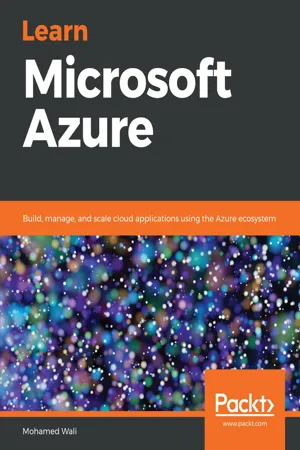
Learn Microsoft Azure
Build, manage, and scale cloud applications using the Azure ecosystem
- 354 pages
- English
- ePUB (mobile friendly)
- Available on iOS & Android
Learn Microsoft Azure
Build, manage, and scale cloud applications using the Azure ecosystem
About This Book
Explore various Azure services to build solutions that leverage effective design patterns
Key Features
- Create, deploy, and host cloud applications on Azure
- Understand various Azure services that help you host serverless applications
- Explore practical examples to help you secure and troubleshoot your cloud environment
Book Description
Azure is one of the leading public cloud service providers. Thanks to a number of Azure service updates, it continues to make advances in the realm of cloud computing.
Learn Microsoft Azure starts with the fundamentals of cloud computing. You will learn to configure and set up the Azure infrastructure. As you make your way through the book, you'll explore Azure services, along with working on virtual memory systems (VMS) and deployment models. You will understand various services in the Azure ecosystem, such as Azure IoT and Azure Analytics, among others. An easy-to-follow introduction to various cloud design patterns will also add to your efficiency in designing cloud solutions. In the concluding chapters, you'll secure your virtual networks using Network security groups and configure Azure Active Directory (Azure AD) to set a custom domain name and company profile.
By the end of this book, you will have learned to secure and troubleshoot your Azure cloud environment and be fully aware of best practices for Azure cloud administration.
What you will learn
- Understand the cloud services offered by Azure
- Design storage and networks in Azure for your Azure VM
- Work with web apps and Azure SQL databases
- Build your identity management solutions on Azure using Azure AD
- Monitor, protect, and automate your Azure services using Operation Management Suite (OMS)
- Implement OMS for Azure services
Who this book is for
Learn Microsoft Azure is for administrators, cloud engineers, and developers who want to get started with using Azure as their cloud platform and build cloud-based applications for their enterprises.
Frequently asked questions
Information
Understanding Azure Virtual Machines
- Introducing Azure virtual machines
- Creating an Azure virtual machine
- Azure virtual machine storage
- Azure virtual machine networking
Introducing Azure virtual machines
Azure VM statuses
| State | Description |
| Running | The VM is running, and you will get charged for the usage, as usual |
| Stopped | The VM has been shut down from inside the OS, but you can still get charged for the VM, as it is still deployed to the same physical host, and the resources are still reserved for it |
| Stopped (deallocated) | The VM was stopped by the stop button on the VM blade, via the Azure portal |
Azure VM service level agreements
- Two or more VMs within the same Availability Set have 99.95% availability
- Using a single VM that uses premium storage will provide at least 99.9% availability
- Two or more VMs within the same Availability Zone have 99.99% availability
- Fault domain: A group of resources that could fail at the same time. For example, if all of the resources are all running on a single rack, sharing the same power source and physical network switch then, they could fail.
- Update domain: A group of resources that can be updated simultaneously during system upgrades. For example, when Microsoft decides to update/upgrade the hosts on which the VMs run in groups of hosts and not for all of the hosts at the same time, each group is considered an update domain.
- Availability Set: This provides high availability for the VMs by setting VMs within different update and fault domains in the same data center.
- Availability Zone: This does the same thing as an Availability Set, except that it spans across multiple data centers in the same region. Therefore, if one of the data centers faces an outage, you will still have at least one VM running on another data center in the same region.
Azure VM series
- A-Series: This series is most commonly used in dev/test scenarios, and it has been around since the early days of Azure VMs
- B-Series: This series provides the lowest cost of any existing size with flexible CPU usage; it mainly targets web servers, small databases, and dev/test environments
- D-Series: This series has fast CPU and SSD disks, and it is most commonly used in general purpose computing, such as relational databases and every application that requires high IOPS
- E-Series: This series is meant for heavy in-memory applications that require high memory-to-core ratios, such as the relational database servers that need medium to large caches
- F-Series: This series targets the applications that require intensive computing power, such as web servers
- G-Series: This series targets applications that require high memory and fast storage, such as ERP and SAP solutions
- H-Series: This series has very high computing capabilities, and it might fit scenarios that require t...
Table of contents
- Title Page
- Copyright and Credits
- About Packt
- Contributors
- Preface
- Microsoft Azure 101
- Understanding Azure Storage
- Getting Familiar with Azure Virtual Networks
- Understanding Azure Virtual Machines
- Azure Web Apps Basics
- Managing Azure Web Apps
- Basics of Azure SQL Database
- Managing Azure SQL Database
- Understanding Azure Active Directory
- Monitoring and Automating Azure Services Using OMS
- Data Protection and Business Continuity Using OMS
- Assessments
- Other Books You May Enjoy